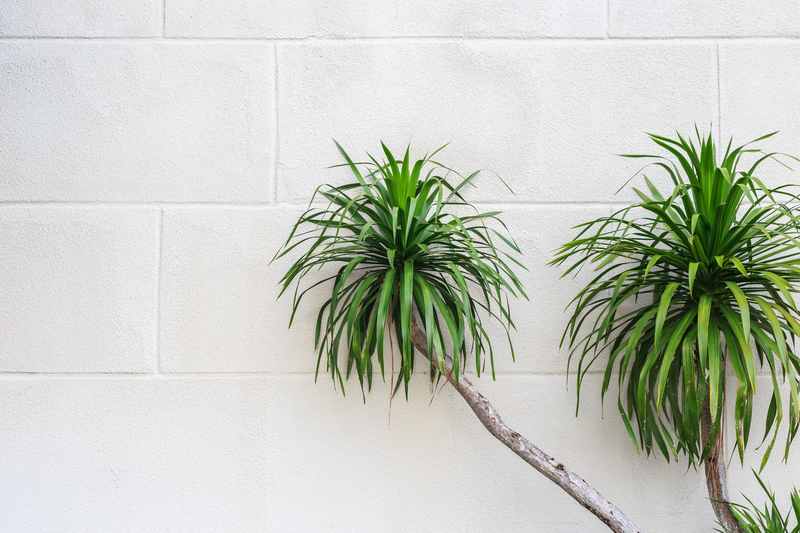Transform Walls into Lush Gardens with Vertical Gardening
Posted on 15/08/2025
Transform Walls into Lush Gardens with Vertical Gardening
Are you dreaming of a lush, green oasis but limited by space? Vertical gardening offers the perfect solution! By transforming plain walls into vibrant gardens, you can maximize your garden potential, improve air quality, and beautify your home or workplace. Whether you have a tiny balcony, an urban patio, or a full-size backyard, vertical gardens bring a fresh perspective to limited spaces. In this comprehensive guide, we'll explore the various vertical gardening techniques, best plants for lush wall gardens, creative DIY approaches, and essential care tips.

What is Vertical Gardening?
Vertical gardening is the practice of growing plants upward rather than outward, utilizing vertical spaces such as walls, fences, and trellises. This innovative concept is revolutionizing urban landscaping, providing a practical way to introduce greenery where traditional gardening isn't feasible.
Benefits of Vertical Gardening
- Space Saving: Ideal for apartments and urban homes with limited ground space.
- Improved Air Quality: Plants filter pollutants and release oxygen.
- Thermal Insulation: Green walls help regulate indoor temperatures and reduce energy bills.
- Reduced Urban Heat: Greener walls absorb sunlight, reducing the heat island effect in cities.
- Enhanced Aesthetics: Adds visual interest and beauty to plain walls.
- Increased Privacy: Dense plantings create natural screens on balconies and patios.
Types of Vertical Gardens
There are several ways to design a thriving vertical garden. Your choice will depend on wall size, lighting, climate, and personal preferences.
Living Walls / Green Walls
Living walls (also called green walls or vertical plant walls) are large structures covered with a variety of plants. These can be pre-built modular panels or custom-built using frames and containers. Living walls often incorporate an integrated irrigation system for convenience and consistent watering.
Trellises and Climbing Plant Supports
Trellises provide vertical surfaces for climbing plants like beans, cucumbers, jasmine, and wisteria. This straightforward method adds lush greenery with minimal infrastructure and is easy to set up in small gardens.
Vertical Planter Pockets
Planter pockets are fabric or felt systems with multiple pouches designed for small herbs, flowers, or leafy greens. They're excellent for indoor vertical gardens or areas exposed to limited sunlight.
Pallet Gardens
Repurposing wooden pallets is a sustainable and budget-friendly way to start your own lush vertical garden. Fill the spaces with potting soil and insert plants between the slats for a charming, rustic look.
Shelf and Stacked Container Gardens
Install shelves or stack containers against your selected wall. This method allows you to tailor plant size, pot arrangement, and ease of maintenance to your needs.
Choosing the Right Location for Your Vertical Garden
Selecting the perfect spot for your vertical gardening project is crucial to plant health and growth. Consider the following factors:
- Sunlight: South or west-facing walls receive the most sunlight. Ensure your chosen plants match the light conditions.
- Wind Exposure: Walls can shield plants from harsh winds, but balconies and rooftops might need sturdier structures or wind-tolerant species.
- Water Access: Choose locations handy for watering, or include an automated irrigation system.
- Wall Strength: Make sure the wall or support structure can handle the garden's weight, especially when watered.
Best Plants for Vertical Walls
The secret to a lush wall garden lies in plant selection. Here are some top choices for a thriving, low-maintenance vertical garden:
Flowering Plants
- Petunias: Colorful and cascading, perfect for vertical gardens.
- Begonias: Shade-tolerant and bloom-rich.
- Fuchsias: Dramatic, drooping blossoms for added dimension.
Foliage Plants
- Ferns: Boston and maidenhair ferns are lush and love humidity.
- Ivy: English and Algerian ivy provide dense, classic greenery.
- Pothos: Hardy, low-light vine ideal for indoor green walls.
Herbs and Edibles
- Basil: Aromatic and useful for cooking.
- Mint: Easy to grow, vigorous spreader.
- Strawberries: Compact and bear edible fruit on trailing stems.
- Lettuce and greens: Leafy crops are fast-growing and fit small pockets well.
Succulents and Low-water Plants
- Sedum: Hardy and drought-tolerant.
- Echeveria: Compact and colorful rosettes.
- Crassula: Popular for their unique shapes and ease of care.
How to Build a Vertical Garden: Step-by-Step Guide
Building a vertical garden doesn't require professional expertise. With some planning and the right materials, you can transform any wall into a living masterpiece.
1. Plan Your Design
- Select your wall or fence, considering sunlight and water access.
- Choose your preferred type (e.g., planter pockets, pallets, modular panels).
- Sketch the layout to estimate the number of plants and supplies needed.
2. Prepare the Structure
- Pallet Garden: Sand and treat the wood to prolong its life.
- Pocket Panel: Secure the panel to the wall using appropriate fasteners.
- Add waterproof backing if indoors to prevent wall damage.
3. Set Up Irrigation
- Install a simple drip irrigation system or plan for manual watering.
- Ensure there's drainage to avoid root rot.
- Use a moisture-retaining substrate or quality potting mix.
4. Plant Selection and Arrangement
- Arrange plants by light requirements (shade vs. sun).
- Mix trailing, upright, and flowering species for layered beauty.
- Start with nursery-size plants for easier establishment.
5. Installation and Aftercare
- Secure plants firmly into their pockets, pots, or frames.
- Water thoroughly after planting.
- Regularly monitor for pests, diseases, and soil moisture.
- Fertilize monthly, or as recommended for chosen plants.
Creative DIY Ideas for Vertical Gardens
Looking to add a personal touch to your vertical garden wall? Try these creative, repurposed structure ideas:
- Recycled Bottles: Mount plastic bottles horizontally on a wooden panel and fill with soil and herbs.
- Shoe Organizers: Hang a fabric shoe organizer on a fence and fill each pocket with hardy plants.
- Gutter Gardens: Attach rain gutters horizontally to a wall. Perfect for strawberries and lettuce.
- Ladder Shelves: Place planters on the rungs of a wooden ladder leaned against a sunny wall.
Common Challenges and Solutions in Vertical Gardening
Vertical gardening comes with its unique set of challenges, but understanding them helps set your lush living wall up for success.
Water Management
- Ensure even watering across all levels. Lower plants may dry out more slowly than top rows.
- Check for water runoff that could damage walls or flooring. Install trays to capture excess water if needed.
Plant Nutrition
- Root zones are limited. Fertilize regularly and use slow-release formulations designed for vertical gardening systems.
Pest Control
- Monitor walls regularly for pests such as aphids and spider mites.
- Encourage beneficial insects or use organic sprays as needed.
Tips for Maintaining a Lush Vertical Garden
- Rotate Plants: Switch out seasonal plants for year-round interest.
- Prune Frequently: Encourage thick, healthy growth and prevent overcrowding.
- Inspect Structure: Regularly check bolts, shelves, or pockets for signs of wear.
- Water Wisely: Consider a smart irrigation timer to avoid under or over watering.
- Light Adjustment: Supplement with grow lights if indoors or in low-light areas.
Transforming Urban Spaces with Vertical Gardens
Cities around the globe are embracing green walls and vertical planters to combat pollution and bring nature to urban settings. From public art installations to commercial buildings and cafes, vertical gardening transforms dull walls into lush, living landscapes that inspire and uplift communities.
The Environmental Impact
- Improved Urban Air: Dense plantings capture dust and filter out toxins.
- Biodiversity Boost: Attracts pollinators, birds, and beneficial insects.
- Stormwater Management: Vertical gardens absorb rainwater, reducing runoff and local flooding.

Frequently Asked Questions About Vertical Gardening
-
Can I build a vertical garden indoors?
Absolutely! Choose shade-loving plants and ensure adequate humidity and indirect light. -
How much maintenance does a living wall require?
Moderate. Check water and nutrients weekly, prune monthly, and replace plants as needed for constant lushness. -
What's the cost of starting a vertical garden?
Budgets vary. DIY projects using recycled materials cost less, while professional green walls can be more expensive due to custom irrigation and specialized structures. -
Are vertical gardens only suitable for flowers and herbs?
No! Many vegetables, succulents, and even small fruits can thrive in a vertical setup with proper care. -
Can vertical gardens be moved?
Yes, container and modular panel vertical gardens can be relocated, making them versatile for renters and homeowners alike.
Conclusion: Elevate Your Space with Vertical Gardening
There's never been a better time to transform your walls into lush gardens. Whether you want to revitalize a dull exterior, grow fresh food at home, or simply enjoy more greenery in a compact area, vertical gardening opens a world of possibilities.
Start small with a DIY pallet herb wall, or go big with a vibrant living wall installation. With a little planning and creativity, you'll turn wasted wall space into a thriving, green sanctuary--no matter your gardening experience!
Ready to unleash the beauty of vertical gardening in your home or community? Let your walls come alive and enjoy the benefits of a lush, vertical garden oasis today.

